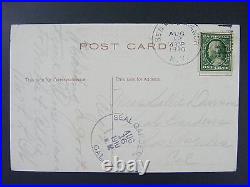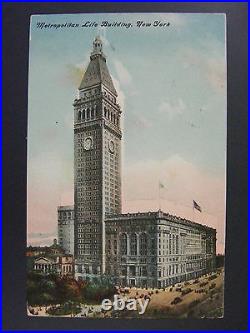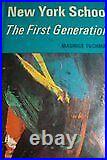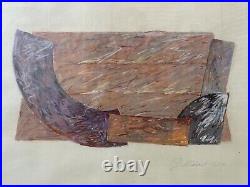

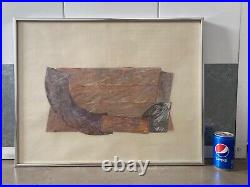
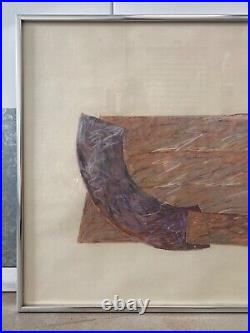

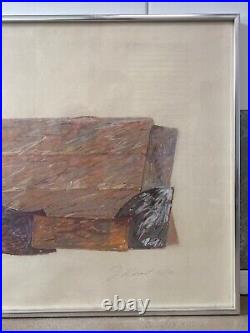
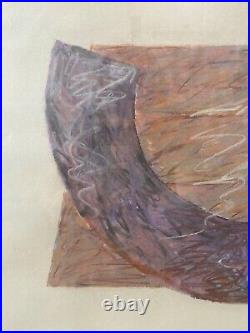
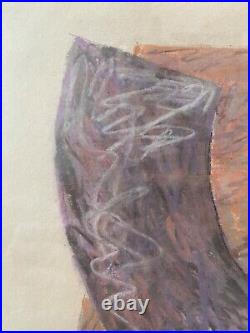
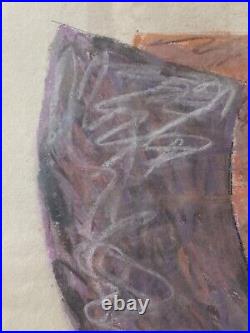
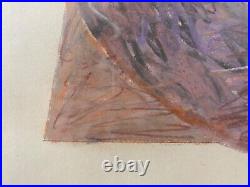


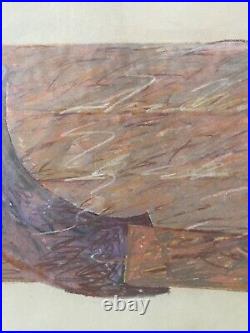
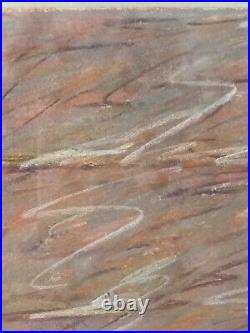
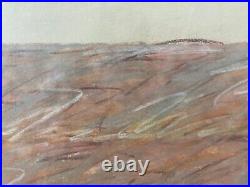
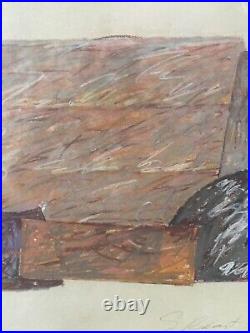
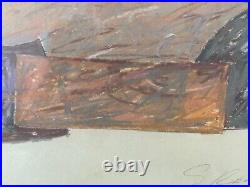
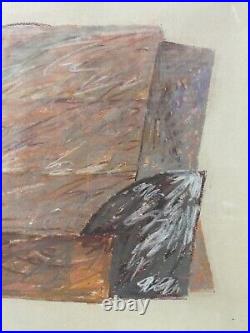





This is a visually striking and Avant-garde RARE Vintage Modern New York Constructivism Abstract Painting, Gouache or Pastels on paper, depicting an abstracted and hard-edged geometric image of intersecting shapes, colors, and texture designs. This artwork is by renowned New York Modernist painter, George Rodart b. 1943, and was acquired directly from the contents of the artist’s former art studio in Los Angeles County, California. Signed and dated in the lower right corner: G. Approximately 18 1/4 x 23 1/4 inches including frame. If you like what you see, I encourage you to make an Offer. Please check out my other listings for more wonderful and unique artworks! George Rodart (Born 1943) is active/lives in United States. George Rodart is known for Painting. George Rodart was raised in Pasadena California. He initially studied Physics, and later, after working in the computer industry and on the Apollo Project, enrolled at UCLA to study art. Rodart mentored with Richard Diebenkorn and John McCracken, graduating with a MFA. In Los Angeles he exhibited with the Ulrike Kantor gallery. Rodart was included in the Whitney Biennial in 1975 and again in 1983. In 1984 he received a Guggenheim Fellowship in painting. He moved to NYC, entered a relationship, raised a kid and continued his investigations into the nature of painting. He has been painting continuously for fifty years. Rodart’s body of work is exploratory and investigative, an inquiry into how the culture uses the painted image as a vehicle for expression and as a signifier of the cultural moment. Since 2015 his paintings live at the boundary zone between abstraction and representation, in an area of associations dependent on memory, of personal and cultural experiences. His work embraces the meta world of digital experience, moving towards an Abstract Surrealism. My paintings are a visual record of my perceptions and memories at a moment in the present time. They reflect my memories as both an awareness of history and of my transient experience of the present. In the end what I make are just paintings. They are about color and light, about forms and boundaries, about the illusion of space, about traces of my brush’s movement, about their physicality. They are about my vision, about my memory, about my fleeting recognitions, about my associations, about my impressions of past experiences, about my generation’s beliefs and follies, about my life. All these things are arrested in my painted images with the hope they will resonate new memories for another viewer. GEORGE RODART 49 E. 1st Street New York, NY 10003. Born in Los Angeles, California Lives and works in NYC EDUCATION 1972 University of California at Los Angeles, M. 1969 University of California at Los Angeles, B. AWARDS and GRANTS 1983 Guggenheim Fellowship for Painting 1973 Phalen Award for Painting ONE PERSON EXHIBITIONS 1983 Ulrike Kantor Gallery, Los Angeles, CA 1982 Ulrike Kantor Gallery, Los Angeles, CA 1976 California State University, Los Angeles, CA 1976 Tortue Gallery, Los Angeles, CA BIENNIAL EXHIBITIONS 1983 1983 Biennial, Whitney Museum of American Art, New York 1975 1975 Biennial, Whitney Museum of American Art, New York GROUP EXHIBITIONS 2103 Fountain Art Fair, Hullaballoo Collective, New York, NY 1990 “The Painter and His Occasion” Curated by Alan Jones, Marta Cevera Gallery, NYC, NY. 1988 “Group Exhibition”, John Davis Gallery, New York, NY. 1992 “Art at Friends” S. Bitter-Larkin Gallery, New York, NY. 1986 “13 Americans”, CDS Gallery, New York, NY. 1984 “A Broad Spectrum”, Design Center, Los Angeles, CA. “Group Exhibition”, Ulrike Kantor Gallery, Los Angeles, CA 1983 “Group Exhibition”, Ulrike Kantor Gallery, Los Angeles, CA 1982 “Artists Choose Artists”, Selected by R. Diebenkorn, CDS Gallery, New York, NY “Changing Trends-12 Southern California Artists”, Laguna Beach Museum of Art, CA. 1982 “Summer Show”, Carl Borenstein Gallery, Monica, CA “Art and Survival”, Traction Gallery, Los Angeles, CA “Contemporary Triptychs”, Montgomery Gallery, Claremont College, Claremont, CA L. Times”, University Gallery, San Diego State University, San Diego, CA “Contemporary Drawings: In Search of an Image”, University of California at Santa Barbara “California Painting from the Mickey and Ruth Gribin Collection, California State University at Northridge and University of California at Irvine. “Changing Visions”, Margo Levin Gallery, Los Angeles, CA 1981 “Southern California Drawings”, Joseloff Gallery, University of Hartford, Hartford CT. “Variations: Five Los Angeles Painters”, University of Southern California, Los Angeles “Group Exhibition”, Ulrike Kantor Gallery, Los Angeles, CA “Drawings”, University Art Gallery, California State University, Dominguez Hills, CA 1978 “Group Exhibition”, Meghan Williams Gallery, Los Angeles, CA “A Painting Show”, Mt. San Antionio College, Walnut, CA. 1977 “Six from California”, Dorothy Rosenthal Gallery, Chicago, IL “Contemporary Masters”, Libra Gallery, Claremont College, Claremont, CA “New Spirits”, Santa Monica College Art Gallery, Santa Monica, CA. 1975 “Group Exhibition”, Tortue Gallery, Los Angeles, CA “Four Artists”, Vanguard Gallery, Fullerton, CA 1974 “Three Los Angeles Painters”, Idaho State University, Boise, ID “Group Exhibition”, Ellie Blankfort Gallery, Los Angeles, CA “Group Exhibition”, Susan Rush Gallery, San Francisco, CA 1973 “Painting 1973″, Oakland Museum, Oakland, CA SELECTED BIBLIOGRAPHY Kienholz, Lyn, L. 271 Henery, Gerrit, “Artists Choose Artists”, Art News, Oct. 162 Mallinson, Constance, “George Rodart at Ulrike Kantor” Art in America, Oct. 1982 p139 Wortz, Melinda, “The Nation”, Art News, May 1982, p. 135 Gleuck, Grace, “In the Arts: Critics Choices”, The New York Times, 2/21/82 Guide, p. 3 Wilson, William, “Reading Between the Lines”, Los Angeles Times, 2/23/82, Part VI, p. 1 Wilson, William, “Galleries”, Los Angeles Times, Feb 26, 1982, Part VI, p. 11 Knight, Christopher, “Cave Paintings for the Atomic Age” Los Angeles Herald Examiner, Feb 28, 1982, p. RAiR Artist: George Rodart. September 8, 2019. Marshall and Winston Gallery. George Rodart’s exhibition of ten large-scale paintings explore the liminal zone between abstraction and representation. Utilizing accident and free association, he combines simple abstract shapes of cut paper to create larger solid forms which become the central characters of his paintings. In 2016, Rodart completed the first hundred paintings from this series. Then he began planning the next stage, extending his vision into much larger works. Following his move to New Mexico, Rodart’s approach became less traditional, more graphic, and closer to a billboard than a painting. George Rodart was exposed to the arts at a young age, and as a boy took painting classes at the Pasadena Art Museum. He initially studied physics and briefly worked in the computer industry and on the Apollo space project. He received his MFA from UCLA where he studied painting with Richard Diebenkorn. Rodart was included in the 1975 and the 1983 Whitney Biennials. In 1983 he won a Guggenheim award for painting. Spotlight: The evolution of a painter – George Rodart. Roswell Artist-in-Residence George Rodart will have his opening and lecture July 19 at 5:30 p. Followed by a reception at 6 p. In the Marshall and Winston Gallery of the Roswell Museum and Art Center, 1011 N. Rodart’s exhibition of 11 large-scale paintings explore the liminal zone between abstraction and representation. It is always difficult to describe a visual artist with the written word, but in the case of Rodart, it is his background that makes it difficult to choose what to let readers know about the RAiR artist and what to let visitors to his exhibit and lecture learn by themselves. When I visited him in his studio, construction workers were in the midst of doing some repair on his apartment. He said he had adapted to New Mexico by getting up and working on his art at 4 a. And when the heat of summer is at its fiercest, stopping at 2 p. Just as these workers do. Rodart’s studio is in an artistic (dis-)order, with paint lined up in repurposed tubs, paper cutouts laying on a neat pile, canvases lined up and photos of his grandchildren pinned on the wall. He doesn’t sit still, though he is a septuagenarian, he looks decades younger. Only when he finished hanging three of his huge canvases on the wall, he sits down, “Now it looks like an artist lives here, ” he said. I have a funny story. I was showing my work at his 98th birthday party and so he sent me an invitation. Rodart grew up in the midst of the golden age of abstract impressionists and pop art, which would form his future and put in the seed to continuously reinventing himself while staying true to his art. Talking to the artist, it is obvious that he is very open about his passion, life and his artistic media. His ability to share, Rodart said, comes from his family and background, which has a direct connection to New Mexico, though he has lived most of his life in California and New York City. “My father is the son of a musician, they lived just outside of Mexico City, which I have never seen and I probably never will, ” he said. But they came to New Mexico, to a little town on the other side of Albuquerque, called Rodarte. There weren’t a lot of Rodartes in the western hemisphere. My grandfather was Spanish and I have Basque roots. At one point his family moved to California. I grew up in Pasadena, California, in a middle-class neighborhood. We were the first Latinos on the block. I didn’t understand anything about races when I was a boy. My mother sang opera, I studied music. My mother came from Italy when she was only four. There were economic difficulties in Italy, so they sent the children over. She lived with an Irish uncle of all things. He was in the restaurant business. As it is often in first generation families, Rodart’s family spoke only English at home. Rodart said, when he learned about RAiR and about its involvement in art education for the children in town, it struck a personal note. As a young boy, he said his mother took him to the Pasadena Art Museum, only six blocks away from where he lived, and signed him up for painting lessons at age 10. “Fifty years later, I realized I was being taught by fledgeling abstract impressionists, who worked for the museum, ” Rodart said. Because of this museum, I got my exposure to art. Pasadena also had an art faire every year in which I participated as a teenager, but that exposure I had at the age of 10 laid the foundation. From that point on, I developed a fairly elaborate relationship with the museum; I knew all the ladies who worked in there. I wasn’t a member, but they let me in. So I attended the (Marcel) Duchamp retrospective (1963). I didn’t even know who Duchamp was, I was maybe 20 at the time. Rodart’s father had become an engineer and was guiding his son to get into a scientific field, so he studied engineering as well, working for early computer companies and becoming an information technology expert. “I wasn’t good at the technical training, but I was good at drawing, ” Rodart said. I worked for a couple of smaller companies. One of them had me working on a lunar project – I designed a little part that was part of the pack of the man who walked on the moon. So, I had all this technological training and then basically kind of decided,’enough. He was accepted at the University of California Los Angeles where he got his Bachelor of Fine Arts degree and then his Master of Fine Arts. At that time, nobody taught marketing or any business aspects connected to the arts, so he started a group to help each other. A lot of us lived in Venice, California at the time. So, we had this little group. We continued the things we did at school. We shared credits of our work; we taught each other how to create a resume and slides. I worked as a carpenter in’75, I was having a hard time to get anybody to pay attention to my work. Rodart moved to New York City. It was rough in’75, but not by’83, unless if you went out to the Bronx. The first time I went to New York City, I stayed with a friend on the floor, typical kind of stuff you did when you were young. We would be walking to East Village and turned around to walk back, it was real creepy. It was still burned out in a lot of places. “I did the art thing for a while, the relocation from California to New York (City) was more difficult than I thought it would be, ” Rodart said. It takes a long time to get used to a new city. The second thing was, I was trying to raise a family, I was into being a responsible father. Rodart withdrew from the exhibition scene, though he continued making art. The majority of art he was creating was investigative and exploring the foundations of painting. While not being active in the art world because of his family, Rodart joined group exhibitions all over the country, including the 1977 Six from California exhibit at the Dorothy Rosenthal Gallery in Chicago, Illinois; in 1981 Southern California Drawings at the Joseloff Gallery, University of Hartford in Hartford, Connecticut; 1982 became a very active year and in 1983, Rodart received the sought-after Guggenheim Fellowship for Painting. From here on, a stable art career kept him in the city. Fast forward to 2015 when a health scare forced Rodart to address his mortality. While other successful artists see their lifetime of work completed at 70, Rodart looked at his work and started to reinvent himself anew. He wanted to reach higher, he said, to start a new style, not to repeat outdated art that no longer had a connection to its purpose. “I imagined myself in this big control room, identifying all this stuff around me, ” Rodart said. I got to thinking, how do we do this? How do we recognize stuff? How do we see things. Rodart became fascinated with the progression of artificial intelligence that shows how the learning process functions. He was also fascinated with cultural aspects on how people literally see art. In 2016, Rodart completed the first 100 paintings from this series. Then he began planning the next stage. Rodart’s style changed from him finding inspiration and finding objects and figures in painting, to using cut-out forms that he arranges and re-arranges until recognition, adding to this, he switched in Roswell from oil paint to acrylics, experimenting during his time as RAiR with different structures. “This would not work with oil, ” he said. Following his move to New Mexico, Rodart’s approach became less traditional, more graphic and closer to a billboard than a painting. This is due to the space he has at the RAiR compound. “This is the biggest and nicest studio I ever had, ” he said. While the paintings he had started in New York City were on a smaller scale, he started creating large collages on canvas that he himself stretched and primed, adding then the cut-outs until he recognizes an object or figure before painting. The results are 11 large pieces of art for the upcoming exhibit. “I didn’t really understand at the beginning what was happening, ” Rodart said. If I think about painting, I think all painting is abstract. Because what you are doing is taking something from the outside world and codifying it on a surface. A photo realist has a high degree of informational content. He makes it conform to a photo. It takes something like Picasso’s “Weeping Woman” painting (which, instead of depicting the Spanish Civil War directly, shows one person suffering). It is one of the most extraordinary paintings ever painted in my opinion. When you look at the painting and don’t see a specific person, but you get this incredible angst, this incredible sadness that comes from the intensity of the image. In-between representation and abstraction, it’s all abstraction, but it is about the degrees of correspondence about the thing you are thinking about on the outside. A photographic image is what we think we see, but we don’t. We know there are other things, like the back (of a person or object). I don’t know exactly, you fill in the image. You don’t worry most of the time, you don’t need to. “The degree of correspondence varies all along, and for me, there is a place in the middle, ” Rodart said. If you find something literal, I do that, but that is something that just happens, I let the work happen. These things are very concrete. These subjective views fascinate Rodart and where those views come from, it can be cultural or come from life experience. Rodart, however, does want the onlooker to find their own view of his art, that’s why he rarely gives his work titles, but rather numbers to identify and to catalogue. Painting has a long history and my recent interest has to do with what I discovered about how we attribute meaning to things, how we attribute recognition, and I use the word’association’ a lot when I talk about these things. I make something until I have some kind of association with it, it kind of looks like a figure. I have a lot of things where I play around with some shape. The public has until Sept. 8 to see Rodart’s exhibit. He hopes and wishes to remain in Roswell, feeling an affinity with the open landscape, which is so different to the skyscrapers of New York City. His staying, however, will depend on the success of his plans to bring more attention to Roswell’s art scene and its possibilities. “The thing is, they should never underestimate the importance of having the two museums, the miniature museum and the music events, ” Rodart said. Those cultural things are a huge draw to relocating businesses. It’s pretty extraordinary and a pretty extraordinary place.

